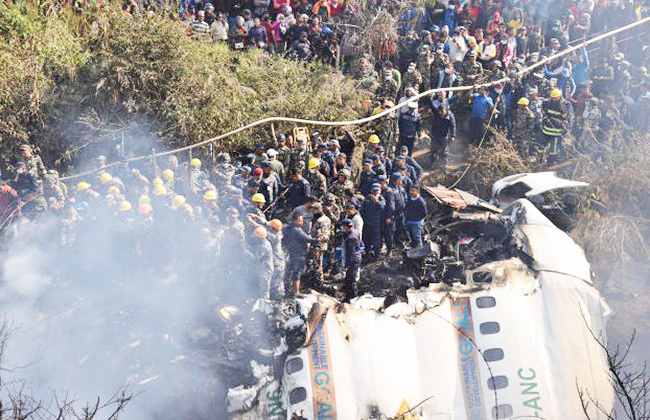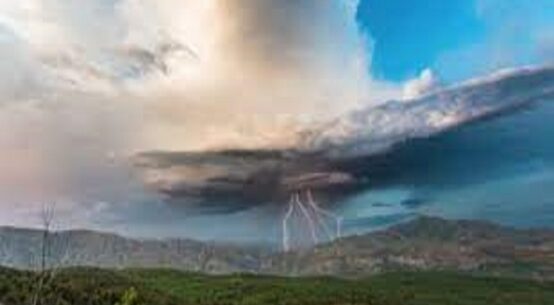
Scores of rescue workers and onlookers crowded near a steep gorge outside a resort town in central Nepal where a regional passenger plane crashed Sunday, as rescuers combed the wreckage on the edge of the cliff and in the ravine below.So far, 68 people have been confirmed dead after a regional passenger plane with 72 aboard crashed into a gorge while landing at a newly opened airport in the resort town of Pokhara, according to an announcement posted by the country’s Civil Aviation Authority to Twitter. It’s the country’s deadliest airplane accident in three decades.It was not immediately clear what caused the accident.
A witness said he saw the aircraft spinning violently in the air after it began to attempt a landing, watching from the terrace of his house. Gaurav Gurung said the plane fell nose-first towards its left and then crashed into the gorge. At the crash site near the Seti River, about 1.6 kilometers (nearly a mile) away from Pokhara International Airport, rescuers sprayed fire hoses and heaved ropes down to another smoldering part of the wreck below. Some bodies, burned beyond recognition, were carried by firefighters to hospitals, where grief-stricken relatives had assembled. At Kathmandu airport, family members appeared distraught as they were escorted in and at times exchange heated words with officials as they waited for information.
“The plane caught fire after the crash. There was smoke everywhere,” Gurung said.The aviation authority said the aircraft last made contact with the airport from near Seti Gorge at 10:50 a.m. before crashing.The twin-engine ATR 72 aircraft, operated by Nepal’s Yeti Airlines, was flying from the capital, Kathmandu, to Pokhara, a 27-minute flight. It was carrying 68 passengers including 15 foreign nationals, as well as four crew members, Nepal’s Civil Aviation Authority said in a statement. The foreigners included five Indians, four Russians, two South Koreans, and one each from Ireland, Australia, Argentina and France. No survivors have been found yet.
Tek Bahadur K. C., a senior administrative officer in the Kaski district, said he expected rescue workers to find more bodies at the bottom of the gorge.Images and videos shared on Twitter showed plumes of smoke billowing from the crash site as rescue workers, Nepali soldiers, and crowds of people gathered around the wreckage of the aircraft to find survivors. The aircraft’s fuselage was split into multiple parts that were scattered down the gorge.Prime Minister Pushpa Kamal Dahal, who rushed to the airport after the crash, set up a panel to investigate the accident.
“The incident was tragic. The full force of the Nepali army, police has been deployed for rescue,” he said.South Korea’s Foreign Ministry said in a statement that it’s still trying to confirm the fate of two South Korean passengers and has sent staff to the scene. The Russian Ambassador to Nepal, Alexei Novikov, confirmed the death of four Russian citizens who were on board the plane.The type of plane involved, the ATR 72, has been used by several airlines around the world for short regional flights. Introduced in the late 1980s by a French and Italian partnership, the aircraft model has been involved in several deadly accidents over the years. In 2018, an ATR 72 operated by Iran’s Aseman Airlines crashed in a foggy, mountainous region, killing all 65 aboard.
In Taiwan two earlier accidents involving ATR 72-500 and ATR 72-600 aircrafts happened just months apart.In July 2014, a TransAsia ATR 72-500 flight crashed while trying to land on the scenic Penghu archipelago between Taiwan and China, killing 48 people onboard. An ATR 72-600 operated by the same Taiwanese airline crashed shortly after takeoff in Taipei in February 2015 after one of its engines failed and the second was shut down, apparently by mistake. The 2015 crash, captured in dramatic footage that showed the plane striking a taxi as it hurtled out of control, killed 43, and prompted authorities to ground all Taiwanese-registered ATR 72s for some time. TransAsia ceased all flights in 2016 and later went out of business.
ATR identified the plane involved in Sunday’s crash as an ATR 72-500 in a tweet. According to plane tracking data from flightradar24.com, the aircraft was 15 years old and “equipped with an old transponder with unreliable data.” It was previously flown by India’s Kingfisher Airlines and Thailand’s Nok Air before Yeti took it over in 2019, according to records on Airfleets.net. Yeti Airlines has a fleet of six ATR72-500 planes, company spokesperson Sudarshan Bartaula said.
Pokhara, located 200 kilometers (125 miles) west of Kathmandu, is the gateway to the Annapurna Circuit, a popular hiking trail in the Himalayas. The city’s new international airport began operations only two weeks ago. It was built with Chinese construction and financial support. The Chinese ambassador to Nepal, Chen Song, said in a tweet he was “very shocked” to learn of the accident. “At this difficult time, our thoughts are with Nepali people. I would like to express my deep condolences to the victims, and sincere sympathies to the bereaved families,” he wrote.
Sunday’s crash is Nepal’s deadliest since 1992, when all 167 people aboard a Pakistan International Airlines plane were killed when it plowed into a hill as it tried to land in Kathmandu.Nepal, home to eight of the world’s 14 highest mountains, including Mount Everest, has a history of air crashes. According to the Flight Safety Foundation’s Aviation Safety database, there have been 42 fatal plane crashes in Nepal since 1946.Last year, 22 people died when a plane crashed on a mountainside in Nepal. In 2016, a Tara Air Twin Otter flying from Pokhara to Kathmandu crashed after takeoff, killing all 23 people aboard.
In 2012, an Agni Air plane flying from Pokhara to Jomsom crashed, killing 15 people. Six people survived. In 2014, a Nepal Airlines plane flying from Pokhara to Jumla crashed, killing all 18 on board. In 1992, all 167 people aboard a Pakistan International Airlines plane were killed when it plowed into a hill as it tried to land in Kathmandu.The European Union has banned airlines from Nepal from flying into the 27-nation bloc since 2013, citing weak safety standards. In 2017, the International Civil Aviation Organization cited improvements in Nepal’s aviation sector, but the EU continues to demand administrative reforms.


